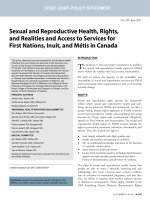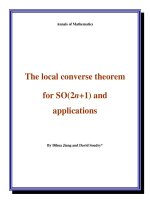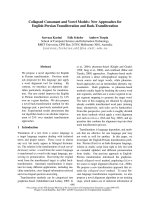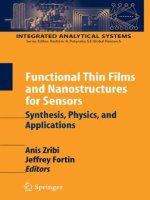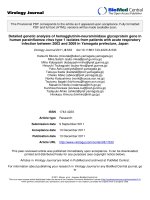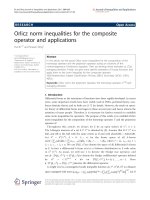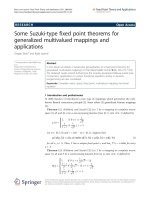Mathematical models with delays for glucose insulin regulation and applications in artificial pancreas
Bạn đang xem bản rút gọn của tài liệu. Xem và tải ngay bản đầy đủ của tài liệu tại đây (2.48 MB, 165 trang )
MATHEMATICAL MODELS WITH DELAYS FOR GLUCOSE-
INSULIN REGULATION AND APPLICATIONS IN
ARTIFICIAL PANCREAS
WU ZIMEI
(M. ENG. Sichuan University, China)
A THESIS SUBMITTED
FOR THE DEGREE OF DOCTOR OF PHILOSOPHY
DEPARTMENT OF MECHANICAL ENGINEERING
NATIONAL UNIVERSITY OF SINGAPORE
2013
I
DECLARATION
II
ACKNOWLEDGEMENT
There are many people who have helped me during my study, and this work would
not finish without their contributions. First of all, I would like to express my deep
gratitude to my supervisor Dr. Chui Chee Kong and Prof. Hong Geok Soon for their
guidance and help on my research. They made a deep impression on me for their
experience, the generous share with me and their dedication to the scientific research. It is
my great honor to pursue PhD degree under their supervision.
I would like to thank Dr. Chang K.Y. Stephen from the Department of Surgery,
National University Hospital and Dr. Eric Khoo from Department of Medicine, National
University of Singapore for their helpful suggestions and kind help. I appreciate the help
from MS. Wang Xiaoyan for organizing the clinical data of diabetic patients.
Thanks for my lab-mates: Wu Yue, Wu Jiayun and Bai Fengjun for their support
and encourage during my study in NUS. Thanks for my colleagues Ho Yick Wai and
Nguyen Phu Binh for their suggestions for my research. I wish to thank all my friends in
Singapore for their help and company. I would like to thank my parents and brother for
their encouragement and support.
It is my honor to study in the Department of Mechanical Engineering, National
University of Singapore. The financial support of National University of Singapore is
gratefully acknowledged.
Lastly, I am very grateful to the examiners of this thesis for their reviews and
helpful feedbacks.
Wu Zimei
1 January 2013
III
Table of Contents
DECLARATION I
ACKNOWLEDGEMENT II
Table of Contents III
Summary VI
List of Tables VIII
List of Figures IX
List of Abbreviations XIV
1 Introduction 1
1.1 Diabetes Mellitus 1
1.2 Closed-Loop Insulin Delivery System 3
1.2.1 Types of Closed-Loop Insulin Delivery System 3
1.2.2 Prototypes of Closed-Loop Insulin Delivery System in Market 4
1.3 Motivation and Scopes 6
1.4 Thesis Organization 8
2 Review of Virtual Patient Models 10
2.1 Bergman Minimal Model 14
2.2 Sturis Model 17
2.3 Hovorka Model 19
2.4 Summary 22
3 Model of Glucose – Insulin System with Delays 23
3.1 Periodic Oscillation of Insulin 23
3.1.1 Rapid Oscillation 24
3.1.2 Ultradian Oscillation 25
3.2 Models of Ultradian Oscillation of Glucose-Insulin System 28
3.3 Modeling Glucose-Insulin System with Two Explicit Delays 32
3.3.1 Structure of Glucose-Insulin Model
32
3.3.2 Glucose Dynamics of the Two-compartment Model 36
3.3.3 Insulin Dynamics of the Two-compartment Model 39
IV
3.4 Physiological Analysis of the Model Parameters Effect on the Oscillatory Behavior
of the System 41
3.4.1 Insulin Transfer Rate Constants m
1
42
3.4.2 Insulin Transfer Rate m
2
43
3.4.3 Plasma Insulin Degradation Rate m
3
44
3.4.4 ISF Insulin Clearance Rate m
4
45
3.4.5 HGP Delay τ
1
46
3.4.6 Insulin Secretion Delay τ
2
47
3.4.7 Combined Effect of the Two Delays 48
3.4.8 Glucose Infusion Rate G
in
50
3.4.9 Discussion 51
3.5 Summary 57
4 Model of Glucose-Insulin System with Subcutaneously-Injected Insulin 59
4.1 Introduction 59
4.2 Models of Subcutaneous Insulin 62
4.2.1 Compartmental Models 63
4.2.2 Non-Compartmental Models 69
4.3 Modeling Glucose-Insulin System with Subcutaneously-Injected Insulin 72
4.3.1 Model of Glucose and Insulin Subsystems 72
4.3.2 Models of Meal 75
4.4 Clinical Evaluation of Model with Subcutaneously-Injected Insulin 79
4.4.1 Material 79
4.4.2 Methods 80
4.4.3 Results and Discussion 83
4.5 Summary 92
5 Glucose Control Using Model Predictive Controller 96
5.1 Model Predictive Control 96
5.2 Glucose Control using Two-compartment Model and Minimal Model 99
5.3 Glucose Control with Injected Insulin 109
5.4 Summary 119
6 Conclusion and Future Work 122
V
6.1 Conclusion 122
6.2 Future Work 125
6.2.1 Model Improvement 125
6.2.2 Abnormalities of Ultradian Oscillations 127
Bibliography 129
VI
Summary
With development of insulin, blood glucose meters and insulin delivery devices,
automatic regulation of glucose level is feasible. Closed-loop insulin delivery system
(also known as an artificial pancreas) could potentially be the ultimate solution for blood
glucose control in diabetic patients. Three indispensable factors of a blood glucose
regulation device are: glucose sensor for measuring glucose concentration, control
algorithm regulating external insulin infusion, and insulin infusion device. With good
knowledge of the physiology of blood glucose regulation, an accurate glucose-insulin
interaction model and a safe, efficient glucose control algorithm could be developed.
Many researchers have proposed models of human glucose-insulin system to match
predicted mechanism of endocrine system and investigate the underlying causes of
diabetes. Optimal glucose control can be achieved by subcutaneous insulin delivery after
subcutaneous glucose measurement. It is crucial to investigate dynamics of glucose and
insulin in the subcutis. A new two-compartmental model with two explicit delays on
hepatic glucose production and insulin secretion was applied to investigate the oscillatory
behavior of glucose-insulin system when there is no external insulin delivery. Four
parameters in insulin system and two delays were analyzed for their influence on glucose-
insulin system; their ranges were estimated for sustaining the oscillations and discussed.
Effect of these parameters on the lag between glucose and insulin in different
compartments provide insights on distribution and metabolism of glucose and insulin in
different compartments. Physiological delay has been demonstrated to be an important
issue for effective blood glucose regulation.
Local degradation and time delay of transportation and absorption should be
considered in the insulin module of the glucose-insulin system if exogenous insulin is
VII
injected in the subcutaneous tissues. Based on the two-compartmental model, a modified
model, including two absorption channels and local insulin degradation, was proposed to
simulate glucose-insulin system with external insulin delivery. Two rate parameters
expressing insulin transportation from subcutis to plasma compartment, two delays and
two parameters expressing the dysfunction of diabetic patients were adjustable and
estimated using nonlinear least squares method. Clinical data comprising glucose level,
insulin injection dosage and meals was collected from diabetic inpatients. By comparing
fitting results with existing model, the proposed model can mimic the dynamics of
glucose and insulin. The estimated model parameters were physiologically meaningful,
and provided insights on the subject’s dysfunction due to diabetes.
The goal of a model predictive control (MPC) is to minimize an objective function
by selecting optimal input moves. MPC has been used in glucose level regulation. Insulin
dosage calculated by the MPC controller is the input to the plant (i.e., human body).
Glucose level was output and feed to MPC controller. Two MPC controllers using the
two-compartment model and the model including the dynamics of subcutaneous insulin
were investigated, and results of glucose control were compared with that of Bergman
minimal model and Hovorka model, respectively. MPC controllers using our models
were demonstrated to be able to reduce occurrence of hypoglycemia and hyperglycemia,
cost less insulin and better deal with glucose changes caused by unnoticed glucose
disturbances.
VIII
List of Tables
Table 2.1. Definition and value of Sturis model parameters……………… 19
Table 2.2. Definition of Hovorka model variables…………………… ………. 21
Table 2.3. Definition and value of Hovorka model parameters…………….… 22
Table 3.1. Studies on the oscillatory behavior of glucose-insulin system.…… 26
Table 3.2. Models of investigating oscillations of glucose-insulin system…… 29
Table 3.3. Range of time delays………………… ……………………………. 31
Table 3.4. Definition of state variables of the two-compartment model……… 35
Table 3.5. Parameters definition and nominal values in the model……… 35
Table 3.6. Distribution volumes for glucose and insulin
in different
compartments 36
Table 3.7. Ranges of model parameters for different subjects. ……………… 56
Table 4.1. Parameters value for the glucose absorption model. ……………… 79
Table 4.2. Model constants of our model. …………………………………… 81
Table 4.3. Information of the five diabetic subjects. ………………………… 85
Table 4.4.
Time and size of meal intake and insulin injections of the five
subjects……………………………………………………………… 86
Table 4.5. Parameters value of our model and Hovorka model of three Type 1
cases. ……………………………………………………………… 87
Table 4.6. Parameters range of our model for the twenty-two Type 2 subjects 87
Table 5.1. Parameter value of minimal model………………………………… 101
IX
List of Figures
Figure 2.1.
Block diagram of the minimal model. The solid arrows represent
material flow, the dashed arrows imply the interactions between
compartments, and the dotted arrow presents the effect of plasma
insulin on the remote compartment…………………………………… 15
Figure 2.2.
Flow diagram of Sturis model. Solid arrows represent exchange rate,
flows of input and output; dashed arrows represent metabolic
relationship between compartments………………………………… 16
Figure 2.3.
Compartment model of glucose-insulin system proposed by Hovorka
et al Solid arrows represent exchange rate, flows of input and output;
and dashed arrows represent insulin action on glucose metabolism… 20
Figure 3.1.
Different amplitudes and periodicities of insulin and glucose for
different glucose infusion rates: (A) meal ingestion; (B) oral glucose
intake; (C) continuous enteral nutrition; (D) constant glucose
infusion……………………………………………………………… 24
Figure 3.2.
Diagram of two-compartment model. The solid and dashed arrows
represent input, output, exchange of glucose and insulin,
respectively……………………………………………………………. 33
Figure 3.3.
Change of HGP with plasma insulin level…………………………
37
Figure 3.4.
Effect of plasma glucose level on IIGU………………………
38
Figure 3.5.
Change of IDGU with ISF glucose level when ISF insulin is constant
at 6 μU/mL (A), and the relationship of IDGU with ISF insulin level
when ISF glucose is constant at 90 mg/dL (B)……………………… 38
Figure 3.6.
Change of insulin secretion rate with plasma glucose level…………
40
Figure 3.7.
Phase plane of glucose and insulin in the plasma (A), glucose and
insulin level distribution (B), and glucose level difference (C) when
m
1
changes. The triangle indicates glucose and insulin in plasma go to
a steady state when m
1
=0.01. The level difference was calculated as
1- ISF glucose level/plasma glucose level…………………………… 43
Figure 3.8.
Phase plane of glucose and insulin in the plasma (A), and plasma and
ISF glucose level difference (B) when m
2
changes……………… 44
Figure 3.9.
Phase plane of glucose and insulin in the plasma (A), glucose and
insulin level distribution (B), and glucose level difference (C) when
m
3
changes……………………………………………………………. 45
Figure 3.10.
Plasma glucose and insulin level distribution (A), and plasma and ISF
glucose level difference (B) when m
4
changes……………………… 46
X
Figure 3.11.
Phase plane of glucose and insulin in the plasma (A), and plasma and
ISF glucose level difference (B) when τ
1
changes. Both glucose and
insulin in plasma reach a steady state with τ
1
≤12 min……………… 47
Figure 3.12.
Phase plane of glucose and insulin in the plasma (A), and plasma and
ISF glucose level difference (B) when τ
2
changes……………………. 48
Figure 3.13.
Phase plane of glucose and insulin in the plasma (A), and plasma and
ISF glucose level difference (B) when the sum of the two delays is
equal to 24.6 min……………………………………………………… 49
Figure 3.14.
Phase plane of glucose and insulin in the plasma (A), range of plasma
glucose and insulin (B), and plasma and ISF glucose level difference
(C) when GIR changes. ……………………… 51
Figure 3.15.
The effect of m
1
, m
2
, m
3
, and m
4
on the change of lag and oscillation
period. The oscillation period was divided by 10 in Figure 4.15 and
Figure 4.16. In Figure 3.15 and Figure 3. 16, the definitions for the
four lines in each panel are as following: green dash lines with star
marker: lag of ISF glucose behind plasma glucose; blue solid lines:
oscillation period; black dot lines with diamond marker: lag of ISF
insulin behind plasma insulin; and red dash-
dot lines with circle
marker: lag of plasma insulin behind plasma glucose………………… 53
Figure 3.16.
Effect of τ
1
(A), τ
2
(B), sum of two delays (C) and GIR (D) on the
change of lag and oscillation period ………………………………….
54
Figure 4.1.
Diagram of SC insulin model proposed by Kobayashi et al. ………
63
Figure 4.2.
SC insulin model proposed by Kraegen and Chisholm. ……………
64
Figure 4.3.
SC insulin model proposed by Puckett and Lightfoot. …………… …
65
Figure 4.4.
SC insulin model proposed by Hovorka et al. ………………… …….
67
Figure 4.5.
SC insulin model proposed by Wilinska et al. ………… …………….
68
Figure 4.6.
Model of glucose-insulin system with subcutaneously-injected
insulin. ………………………………………………………………. 74
Figure 4.7.
The glucose profiles with various carbohydrate uptake. ……………
78
Figure 4.8.
The normalized SSE of the 25 cases of our model and that of the three
Type 1 cases of Hovorka model…………………………… 84
XI
Figure 4.9.
The comparison result of our model with Hovorka model (Case 1: A,
Case 11: B, Case 17: C). Modeled glucose level and clinical data were
shown in the top panel. In the bottom panel the blue solid and black
dash curves represented glucose intake rate using our model and
Hovorka model, respectively (mmol/min); and the green solid line
represented insulin injection dosage (mU). IS was not considered for
Type 1 subjects, insulin secretion delay τ
2
and α were not
estimated………………………………………………………………. 87
Figure 4.10.
The fitting result of measured glucose with estimated glucose level
using our model for the Type 2 cases with the smallest (A: Case 20)
and highest (B: Case 3) normalized SSE. In the bottom panel, the red
dash curve and the blue lines represented glucose i
ntake rate
(mmol/min) and insulin injection dosage (mU), respectively. In the
left figure, the parameters were estimated: k
a1
=0.14, k
a2
=0.13, τ
1
=37,
τ
2
=45, α=0.42, β
=0.52. In the right figure, the parameters were
estimated: k
a1
=0.22, k
a2
=0.17, τ
1
=34, τ
2
=48, α=0.35,
β=0.32………………………………………………………………… 87
Figure 5.1.
MPC strategy (Adapted from the Model Predictive Control Toolbox
of Matlab)…………………………………………………… ……… 97
Figure 5.2.
Diagram of overall control process (Adapted from the Model
Predictive Control Toolbox of Matlab)……………………………… 98
Figure 5.3.
Diagram of the Bergman minimal model in Simulink………………
101
Figure 5.4.
Diagram of the two-compartment model in Simulink…………………
101
Figure 5.5.
Simulation result using minimal model with three constant glucose
infusions. From Figure 5.5 to Figure 5.12, A: Plasma glucose
concentration (blue), upper and lower limit of normoglycemia range
(red), and desired glucose level (green). In the simulations of this
chapter, the prediction horizon and control horizon is set to be 10 and
5, respectively. The sampling time is 2 minutes. The weight of
manipulated variable and output is 0.1 and 0.9,
respectively……………………………………………………………. 102
Figure 5.6.
Simulation result using two-compartment model with three constant
glucose infusions……………………………………………………… 103
Figure 5.7.
Simulation result using minimal model with constant glucose
infusion……………………………………………………………… 104
Figure 5.8.
Simulation result using two-
compartment model with constant
glucose infusion……………………………………………………… 104
Figure 5.9.
Simulation result using minimal model with impulse glucose
injection……………………………………………………………… 106
XII
Figure 5.10.
Simulation result using two-compartment model with impulse glucose
injection………………………………………………………………. 106
Figure 5.11.
Simulation result using minimal model with glucose infusion
decreasing exponentially……………………………………………… 108
Figure 5.12.
Simulation result using two-
compartment model with glucose
infusion decreasing exponentially…………………………………… 108
Figure 5.13.
Diagram of our model with subcutaneous insulin dynamics for Type 1
cases in Simulink……………………………………………………… 110
Figure 5.14.
Diagram of the Hovorka model for Type 1 diabetic patients in
Simulink………………………………………………………………. 110
Figure 5.15.
Simulation result of MPC controller using Hovorka model (left) and
our model (right) to regulate glucose level of Type 1 diabetic patient
(case 1). From Figure 5.15 to Figure 5.20, Figure 5.22 and Figure
5.23, black stars represent the measured glucose level, red lines
represent upper and lower limit of normal glucose range, and green
line represents the ideal glucose level………………………………… 111
Figure 5.16.
Simulation result of MPC controller using Hovorka model (left) and
our model (right) to regulate glucose level of Type 1 diabetic patient
(case 1) with unnoticed plasma glucose disturbance………………… 112
Figure 5.17.
Simulation result of MPC controller using Hovorka model (left) and
our model (right) to regulate glucose level of Type 1 diabetic patient
(case 11)………………………………………………………………. 113
Figure 5.18.
Simulation result of MPC controller using Hovorka model (left) and
our model (right) to regulate glucose level of Type 1 diabetic patient
(case 11) with unnoticed plasma glucose disturbance………………… 113
Figure 5.19.
Simulation result of MPC controller using Hovorka model (left) and
our model (right) to regulate glucose level of Type 1 diabetic patient
(case 17)………………………………………………………………. 114
Figure 5.20.
Simulation result of MPC controller using Hovorka model (left) and
our model (right) to regulate glucose level of Type 1 diabetic patient
(case 17) with unnoticed glucose disturbance…………………… 115
Figure 5.21.
Insulin dosage used in the simulations
of glucose control using
Hovorka model (Blue squares and circles represent insulin cost
without and with glucose disturbance, respectively), our model (Red
squares and circles represent insulin cost without and with glucose
disturbance, respectively.), and in clinical experiment for the three
Type 1 cases (Green stars represent insulin dosage injected in the
clinical experiment). The y axes is displayed in log
form…………………………………………… …………………… 116
XIII
Figure 5.22.
Simulation result of MPC controller using
our model to regulate
glucose level of Type 2 diabetic patient (case 20) without glucose
disturbance (left) and with glucose disturbance (right). The total
insulin dosages for the two situations are 57.6 U (left) and 57.4 U
(right), respectively……… 117
Figure 5.23.
Simulation result of MPC controller using our model to regulate
glucose level of Type 2 diabetic patient (case 3) without glucose
disturbance (left) and with glucose
disturbance (right). The total
insulin dosages for the two situations are 32.1 U (left) and 32.5 U
(right), respectively. ………… 118
XIV
List of Abbreviations
CGM
Continuous glucose monitoring
CGMS
Continuous Glucose Monitoring System
EGP
Endogenous glucose production
FFA
Free fatty acid
GIR
Glucose infusion rate
HGP
Hepatic glucose production
IS
Insulin secretion
IDGU
Insulin-dependent glucose utilization
IIGU
Insulin-independent glucose utilization
ISF
Interstitial fluid
IVGTT
Intravenous glucose tolerance test
MPC
Model predictive control
MRAD
Median relative absolute difference
NRLS
Non-linear recursive least squares
ODE
Ordinary differential equations
OGTT
Oral glucose tolerance test
PD
Proportional-derivative
PID
Proportional-integral-derivative
PK
Pharmacokinetic
SC
Subcutaneous
SSE
Sum of the square error
1
1 Introduction
1.1 Diabetes Mellitus
Diabetes Mellitus is a common disease around the world, which can induce various
systemic diseases and high mortality. The World Health Organization estimates that there
are more than 180 million people suffering from diabetes, and the number may double by
2030. Diabetes can be catalogued into Type 1 and Type 2 diabetes. Type 1 diabetes, often
occurring among children and young, makes up 5% to 10% of diabetes cases, and is
characterized as inability of producing any insulin by their bodies. While Type 2 diabetes,
usually developing in middle aged or later, is associated with high insulin resistance,
which results in unused glucose cumulating in body to cause hyperglycemia and tissue
damage over time .
High blood glucose level can cause high osmotic pressure in the extracellular fluid
resulting in considerable cellular dehydration. Secondly, high level of glucose would
cause glucose loss in the urine, which is followed by osmotic dieresis depleting fluids and
electrolytes of the body. Besides, long-term high blood glucose can damage many tissues,
especially blood vessels. Low glucose concentration below 45-55 mg/dL for a long
interval may bring about brain function impairment, tremors and convulsions. An
intensive insulin therapy can reduce the risk of complications resulted from diabetes.
Hyperglycemia can be minimized and hypoglycemia can be avoided by proper insulin
delivery.
The conventional therapy of diabetes is multiple subcutaneous insulin injections
using long or short acting insulin analogues after glucose level measurement by glucose
monitor. Insulin pen devices can make insulin delivery more convenient. There are some
2
other routes of insulin delivery such as inhaled insulin, orally administered insulin,
transdermal insulin delivery and so on. Continuous subcutaneous insulin infusion using
external insulin pump has been applied to regulate blood glucose concentration. In the
past decades, some continuous or semi-continuous glucose monitors and insulin infusion
pumps have received approval, both of which promote the development of closed-loop
insulin delivery system. A closed-loop insulin delivery system relying on a continuous
glucose sensor, insulin infusion pump and an advanced control algorithm can be
developed to control blood glucose concentration automatically.
The control algorithm can optimize insulin dose to be delivered to the patient by
insulin pump in order to maintain glucose concentration within the normal range.
Proportional-integral-derivative (PID) method to control blood glucose level has attracted
interests of many researchers [4-7]. Difference between measured glucose level and
reference value multiplied by proportional constant, integrated over a period of time, and
its derivative are used to control the insulin input. Although the simple control approach
is easy to implement, it cannot provide insight into the physiological meaning of the
metabolic system, and human expertise is needed to ensure the successful operation,
which restricts greatly the functioning of this approach. Due to the complexity of
nonlinear dynamics of glucose-insulin metabolic system, model predictive control (MPC)
taking advantage of detailed process models and information regarding process
constraints or limitations is more advantageous in regulating blood glucose concentration.
Advanced control algorithm is one of the three important factors developing closed-loop
insulin delivery system and has been established to aid in the diabetes treatment.
3
1.2 Closed-Loop Insulin Delivery System
The closed-loop insulin delivery system, which is also called artificial pancreas, is
composed of three essential components: a stable glucose sensor for measuring the
glucose concentration, a control system regulating external insulin infusion based on the
glucose-insulin system and a safe and stable insulin infusion device [1].
1.2.1 Types of Closed-Loop Insulin Delivery System
There are two ways to divide the closed-loop insulin delivery system: way of
prandial insulin delivery and the body interface. Glucose excursion by meals is a great
challenge to closed-loop insulin delivery system. In a closed-loop insulin delivery system,
insulin is delivered fully automatically without knowledge of exercise or meals’ time,
size or composites, and it is only based on the evaluation and prediction of the measured
glucose level. In a closed-loop insulin delivery system with meal announcement, the
system is informed of the time and size of the meals and gives out advised prandial
insulin bolus to deliver [2]. There is also a hybrid approach which delivers up to 50% of
bolus insulin and leaves the remaining to be delivered during the feedback.
There are three types of closed-loop insulin delivery system according to the body
interface: sc-sc system (subcutaneous glucose sensing and subcutaneous insulin delivery),
iv-ip system (intravenous glucose sensing and intraperitoneal insulin delivery), and iv-iv
system (intravenous glucose sensing and intravenous insulin delivery). Insulin delivery
via subcutaneous route has advantages over intravenous or intraperitoneal route: low
incidence of infection, less pain and discomfort and ease of administration. The sc-sc
system is easy and safe to implement though it results in insulin absorption delay. The iv-
iv system is usable under some situations such as surgical operations, for critically ill and
4
research investigation. However, this approach is high invasiveness due to the need of
vascular access for the glucose sensing and insulin delivery. Up to now, there are a few
prototypes developed and tested under limiting clinical conditions.
1.2.2 Prototypes of Closed-Loop Insulin Delivery System in Market
Median relative absolute difference (MRAD) is often used to evaluate the
performance of the continuous glucose monitoring (CGM). Freestyle Navigator CGM
(Abbott Diabetes Care, Alameda, CA, US) is reported to achieve an average MRAD of
14% [2]. Continuous Glucose Monitoring System (CGMS, Medtronic Minimed,
Northridge, CA, US) [3] is reported with slightly higher MRAD than Freestyle Navigator
CGM, and DexCom Seven STS [4] with an MRAD of 11.4%. The three CGMs can be
used for 3, 5, and 7 days in a closed-loop insulin delivery system, respectively.
The earliest closed-loop insulin delivery system was the Biostator, Glucose-
Controlled Insulin Infusion System, introduced in 1977, which was an iv-iv system using
a glucose oxidase sensor to measure the glucose level in the blood and peristaltic pump to
deliver insulin and glucose intravenously. The control algorithm of Biostator is
oversimplified. After Biostator, Shichiri’s group developed a wearable artificial pancreas
named STG-22 (Nikkiso Co. Ltd., Japan) [5] using the sc-sc route and sc-ip route, and the
microdialysis type glucose sensor in the system can work up to 7 days.
Medtronic Minimed developed an external physiologic insulin delivery [6]
employing the CGMS (Medtronic Minimed, Northridge, CA, US) and the Medtronic 511
Paradigm Pump with a PID controller [7]. Studies using the system is performed on dogs
[8] and 10 subjects with Type 1 diabetes [6]. Glucose level keeps in the range 3.9-10
5
mmol/L 75% of the time applying closed-loop treatment, compared with that of 63% for
open-loop treatment.
Roche Diagnostics developed a sc-sc semi-closed-loop prototype with meal
announcement employing subcutaneous continuous glucose monitor (SCGM1, Roche
Diagnostics GmbH, Germany) which can monitor glucose level for 4-5 days [9]. Insulin
bolus was administrated every 10 min, which is determined by an “empirical algorithm”
based on clinical observations. The system was tested on twelve Type 1 diabetic subjects
over 32 hours. It was shown that the algorithm can reach near-target glucose level and
reduce the number of hypoglycemia interventions. 60% of SCGM1 readings were in the
range 5-8.3 mmol/L compared to that of 45% under self-directed treatment. An European
Commission funded project Advanced Insulin Infusion using a Control Loop [10] also
developed a sc-sc semi-closed-loop with meal announcement, which is composed of a
minimally invasive glucose monitor system, an insulin pump (Disetronic D-Tron) and a
PocketPC computer. An adaptive nonlinear MPC is applied in the system.
The Renard group developed an implantable insulin delivery system employing a
long-term sensor system [11, 12] which is an intravenous enzymatic oxygen-based sensor
by Medtronic Minimed (Northridge, CA, US) implantable in the superior vena cava. The
pump, implementing Proportional-derivative (PD) control, is implanted in the abdominal
wall and delivers insulin intraperitoneally. The system implemented test on four elderly
Type 1 diabetes subjects over 2 days and for 84.1% time glucose level is in the range of
4.4-13.3 mmol/L [1].
The sc-sc system will gain wide applications in the near future due to its safety and
convenience to implement and maintain. However, there are two physiological factors
6
affecting the performance of a sc-sc system. One is the delay between insulin delivery
and sensed glucose lowering. It would take some time for the glucose level to go down
after the insulin delivery; therefore, subjects using insulin pumps should be alerted insulin
overdosing due to insulin administrations in a close sequence, which is followed by
hypoglycemia. The other factor is the inter-subject variability of insulin delivery.
Actually, developing a “one size fits all” closed-loop system is difficult due to some
factors such as age, gender, body mass index, physical exercise or some other diseases.
For the same person, insulin needs are different day-to-day or even hour-to-hour because
of some physiological or physical reasons. The problem of insulin absorption delay can
be solved by including the delay in the model of glucose-insulin metabolic system. The
second factor causes problem for all the closed-loop insulin delivery systems, which is
expected to be improved by advanced control algorithm such as MPC.
1.3 Motivation and Scopes
Subcutaneous glucose monitoring and insulin delivery is advantageous over the
other two approaches for closed-loop insulin delivery system. Therefore, subcutaneous
tissue is to become the main measurement site of glucose sensor and administration sit of
exogenous insulin. It is therefore important to understand the kinetics interactions of
glucose and insulin between plasma and subcutaneous tissues.
The timing and amplitude difference of plasma glucose and glucose in interstitial
fluid (ISF) may reflect the variation of glucose uptake, utilization and elimination in
blood, ISF and cells [13]. Besides, the lag and amplitude difference are also
characteristics of insulin kinetics between plasma and ISF. However, in most current
7
studies, glucose [14-18] and insulin [15, 18] are considered as a one-compartment model
during the study of the physiological processes. The ignorance of the lag and amplitude
difference of glucose in the two compartments would result in loose control of glucose
level to cause hyper- or hypoglycemia. Therefore, a new two-compartment model is
developed to express the glucose and insulin metabolic system.
The new two-compartment model aims to study the physiological phenomenon and
pathology in diabetes by analyzing the changes of glucose and insulin level, lags existing
in the glucose-insulin system and the effect of model parameters on the oscillatory
behavior of glucose-insulin system. Using the proposed mathematical model, the effect of
the model parameters on blood glucose regulation is investigated. Some key issues are
analyzed from the perspective of physiology and pathology:
• Effect of model parameters on the oscillatory behavior of the glucose-insulin
system.
• Pathological relations of parameters’ change with some diseases related to
abnormal glucose level.
• Influence of model parameters on the interactions of glucose and insulin between
plasma and ISF compartment regarding physiological lags and amplitude
differences.
The two-compartment model without considering external insulin injection/
infusion is developed and analyzed physiologically. For diabetic patients, external insulin
injected subcutaneously is administered to the two-compartment model to simulate the
metabolism of glucose and insulin. It is the first model to include the dynamics of
injected insulin into the glucose-insulin model for type 2 diabetic patients. This model
8
considering the dynamics of injected insulin provides insights on the dynamics of human
blood glucose regulation, and helps derive control algorithms for treatment of diabetic
patients. The following points were studied:
• In order to model insulin absorption delay in the sc-sc insulin delivery system, the
ISF compartment of insulin in the two-compartment model aforementioned was
separated into three compartments considering insulin degradation at the injection
site and two insulin absorption channels.
• Six model parameters value were estimated by fitting the model with injected
insulin to clinical data of diabetic patients, and the fitting result of our model is
compared with that of Hovorka model.
• The six model parameters were discussed physiologically and pathologically
considering the situations of the diabetic subjects.
• MPC controller was investigated using the two-compartment model and the
modified model with subcutaneous insulin, and compared the control performance
with that of using Bergman minimal model and Hovorka model, respectively. The
glucose curves and insulin dosages in the simulations of the models were
compared accordingly to evaluate the performance of glucose control.
1.4 Thesis Organization
The aim of this thesis is to study the oscillatory behavior of glucose and insulin and
assess the feasibility of using the model to control blood glucose concentration for
diabetic patient. A detailed model of glucose-insulin system is indispensable to achieve
this. Chapter 2 introduces some established mathematical models of glucose-insulin
9
system. In chapter 3, a two-compartment model was developed and analyzed
physiologically to investigate the oscillatory behaviors of glucose and insulin. The two-
compartment model was modified to simulate the dynamics of insulin injected
subcutaneously in Chapter 4. The model parameters in the modified model were
estimated using the clinical data of diabetic subjects and discussed and related to diabetes.
MPC controllers were developed in Chapter 5 using the two-compartment model and the
modified model with injected insulin. The control performance of the two models was
compared with that of Bergamn minimal model and Hovorka model, respectively.
Simulation results addressed the challenges in using the current models to design a
closed-loop insulin delivery system. A discussion on the future modeling of glucose-
insulin system was introduced in Chapter 6. Further investigation of virtual patient model
is necessary with the growing understanding of diabetes.
10
2 Review of Virtual Patient Models
Since the development of the concept of “artificial pancreas”, there have been many
researchers studying on the modeling of glucose-insulin regulation system in order to
understand the mechanism of endocrine system and causes of diabetes and develop a safe,
efficient glucose control device to relieve the suffering of the diabetes patients. These
virtual patient models promote the development of advanced control algorithm to regulate
glucose concentration and investigation of the pathophysiology of diabetes.
Most mathematical models of glucose-insulin system are based on the idea of
compartment. When compartmental model is applied to describe the metabolic system
composed of a series of interconnected compartments, there are several specifications
needed to be illustrated: compartment number, input and removal sites, and mathematical
relations of interdependences and controls [19].
The glucose-insulin regulatory system is a complex system controlled by many
cerebral signals and hormones; up to now, there has not been a model which can express
all the interactions of glucose and insulin in the human body. Even, there is much
physiological phenomenon in human being body which still cannot be explained by
researchers. Some models developed during the last few decades are introduced in this
chapter. The advantages and shortcomings of the glucose-insulin models are reviewed in
[20-22].
Virtual patient models can be catalogued into two groups. One is the
pharmacokinetic (PK) model, in which absorption and clearance kinetics are expressed,
and some compartments are determined related to the elimination and absorption. The
other type is the physiological models in which organ system is considered as a

